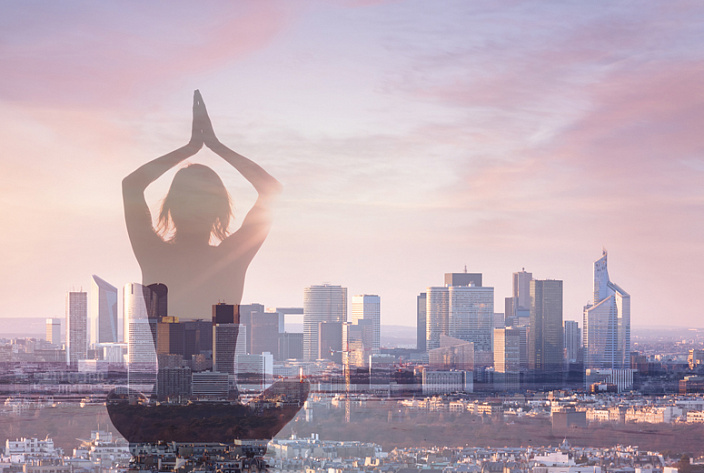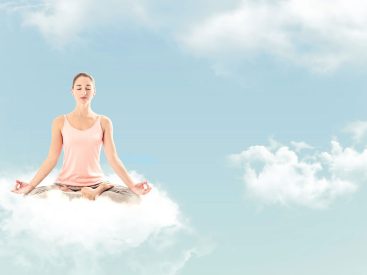Meditation has only one purpose – to go beyond the mind and become a witness. There is a miracle hidden in your testimony, the whole mystery of life.
Bhagavan Rajneesh.
NSthat article is rather unusual. In it you will not read about how important it is to practice meditation, because the author of the article is not trying to convince anyone of this. It is already a well-known fact that meditation has a huge number of positive aspects. From the presented material, you will learn about where real meditation begins, what is its basis and when to start practicing it.
The river, which begins in the mountains and flows into the sea, flows as a single stream. Once, having read this saying, it involuntarily occurred to me that this is nothing more than a metaphor for yoga classes, but complex classes, practicing all the stages of Ashtanga yoga. We will not touch the highest 8th step yet. samadhisince it would be at least strange to call it practice, because samadhi is not a technique or practice, but a state of mind that a practitioner comes to after many years of intensive practice of the previous steps of ashtanga yoga.
What are the basics of meditation for beginners? You could describe it as you usually find on the pages of books or on the Internet, where instructions are provided, specific steps in order to help beginners reach a meditational state of consciousness, turn off thoughts and go beyond the mind.
But let’s go beyond that and look at the topic of meditation not as a separate, independent element of the system, but as an integral component of Ashtanga yoga. Why do most schools and instructors present the practice of meditation as something completely independent and almost magical, either a practice, or a secret teaching that will allow you to ascend to heaven and open new worlds in front of you? Why not imagine the practice of meditation as it is, where it originates from and how it is connected with the entire yogic system. After all, few people know that meditation is, first of all, a part of yoga, its highest level, to which one needs to come, and other stages of the same Ashtanga yoga are being prepared for this:
Here is a list of the steps that precede dhyana, or in the modern way, meditation. Without going through all six of the previous steps, there is no chance of fully preparing yourself for mastering meditation. When people sign up for meditation courses, ignoring such important components as yama and niyama, then the results should not be expected in a day. People suffer, drive their thoughts away, try to concentrate, to find a connection with the Highest. But how, please tell me, do these people want to be instantly transformed through the practice of meditation, without paying attention to other aspects of personality formation ?!
Indeed, despite the fact that meditation is considered to be something very sublime, in reality the achievement of the state of emptiness of the mind – “thoughtlessness” – is the result of the development of the personality itself. The higher the requirements for oneself, the more a person is spiritually developed, until the moment when he first uses certain techniques of meditation, such as meditation on a mantra or dynamic meditation, etc., the more chances that the process of meditation itself will be effective, and not just a struggle with oneself against a banal falling asleep or fleeing from an avalanche of thoughts, which, from nowhere, now in silence, rushed in an incessant stream.
Understand that beginners struggle with themselves and their thoughts due to the fact that the previous processes that are prescribed in the Ashtanga yoga system and recommended for practice for most beginners in meditation were simply not passed by them. They do not even think about it, not considering it necessary to practice, for example, asanas and pranayama before proceeding to the meditation itself.
In order to explain in more detail what has been said above, it is necessary to theoretically explain how yama, niyama, asanas, pranayama, pratyahara and dharana affect the success of the further meditation process, that very deep meditation, which is otherwise called dhyana.
So, let’s imagine that you are already practicing Yama and Niyama, that is, you lead a correct lifestyle, your moral values are at their best, probably you have already adjusted your diet and excluded meat products from it, which means you can approach the third steps of ashtanga yoga and its influence on the preparation for deep meditation.
Through the practice of asanas, you already begin to master the initial stages of meditation. That is why it is good to begin your acquaintance with real meditation through the practice of asanas. An indispensable condition for performing yogic postures is to focus on one or another organ or part of the body. There is a general immersion in the inner world.
Another way, which can be simultaneously practiced with the previous concentration, is attention directed to the breathing process during asanas, which in turn leads to the preparation and practical mastering of pranayama – the next step of yoga, which is otherwise called the “art of controlling and controlling breathing.” … At the same time, the process of concentration itself is nothing more than dharana – the stage immediately preceding dhyana, that is, meditation.
Concentration itself is very important in order to prepare yourself to immerse yourself in deep enough meditation. If you do not know how to concentrate, then you will still spend time on this, performing this or that meditation technique. But in the absence of experience and the ability to long-term concentration on something, say, on an object or awareness of yourself, your thought process, it is difficult to go beyond your own feelings and thoughts. To begin with, you must learn to focus on one thing. In this regard, concentration during the performance of asanas is an excellent starting point for the development of this ability.
If, in addition, you connect the practice of pranayama to the practice of asanas, then the result will exceed your expectations, and instead of waiting for the moment when it will finally be possible to engage in “real” meditation, you will actually already be doing it, initially without giving yourself report. Many beginners do not even realize that by performing the asanas correctly, connecting the ujayi breathing, as is practiced in Vinyasa flow yoga, they are at the origins of meditation, which they go to through serious practice of concentration, which means that they are practicing dharana. It turns out that by doing asanas, you immediately develop several abilities in yourself, which in the future will allow you to move to the highest practices of meditation in the most natural way.
What is the basis of the practice of meditation? It is rather difficult to explain the practical aspect of the meditation process in words, one might even say that it is impossible. It is the same as trying to describe the state of samadhi in words, it is the same as trying to explain the inexplicable, inexpressible, state that is completely different from what you meet in ordinary life, therefore, it is incongruous with the practical side of being. Yes, of course, the practical benefits of doing meditation are undeniable, that is, practicing meditation is beneficial for the body and psyche. They are proven to be beneficial for people with weak hearts and those with diabetes. Also, the practice of meditation increases the intellectual abilities of a person, including improving memory. You can’t list everything.
The results from the practice of meditation are manifested at the physical level, but the “action” itself occurs at higher frequencies. Change in higher areas also leads to positive results on a gross, physical level. And yet this is a kind of side effect of doing meditation. The most important thing happens in your consciousness, it changes, and with it your inner world and personality itself change. The essence of meditation, the process of calming the mind and stopping the thought process is that at this moment there is a transformation and an exit of consciousness to higher levels. Often people are so involved in the practice of meditation that it becomes almost addictive.
Of course, this is not a version of addictions that should be avoided and, if possible, prevented, but nevertheless the psychological need for more frequent meditation than is required can mean one important thing – a person is dissatisfied with the world around him, and meditation plays the role of a cozy a haven to hide in if need be.
It should be remembered that the meaning of meditation is not to separate a person from the real world, but, on the contrary, to make him stronger, less vulnerable in the face of fate. Meditation is not your uninhabited island where you can hide and not leave for years, just because now you do not need the company of other people. You have become fully self-sufficient.
That is why they say that it is easier to become a monk, a Buddhist monk: eat, drink, perform the simple duties of the community, and spend the rest of the time in meditation. Remaining in society and practicing meditation, it is much more difficult to maintain the balance or state of bliss found in meditation, because reality is constantly trying to knock us out of this equilibrium. Therefore, while doing meditation, take it as an excellent method for immersion in yourself, studying your essence, approaching merging with the Absolute, but at the same time remember that the spiritual experience received through meditation must be manifested in physical reality, otherwise the person is endowed with physical characteristics. If the whole point was to be realized in a spiritual hypostasis, then the body itself would not have to exist. And yet it is, and we are in it. It means that you need to use its resources, and again, with the help of realization, at the physical level, make a contribution to the development of your energy and strengthen your spirit.






